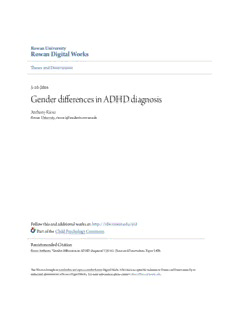
Gender differences in ADHD diagnosis PDF
Preview Gender differences in ADHD diagnosis
RRoowwaann UUnniivveerrssiittyy RRoowwaann DDiiggiittaall WWoorrkkss Theses and Dissertations 5-10-2016 GGeennddeerr ddiiffffeerreenncceess iinn AADDHHDD ddiiaaggnnoossiiss Anthony Rizzo Rowan University Follow this and additional works at: https://rdw.rowan.edu/etd Part of the Child Psychology Commons RReeccoommmmeennddeedd CCiittaattiioonn Rizzo, Anthony, "Gender differences in ADHD diagnosis" (2016). Theses and Dissertations. 1409. https://rdw.rowan.edu/etd/1409 This Thesis is brought to you for free and open access by Rowan Digital Works. It has been accepted for inclusion in Theses and Dissertations by an authorized administrator of Rowan Digital Works. For more information, please contact [email protected]. GENDER DIFFERENCES IN ADHD DIAGNOSIS by Anthony G. Rizzo A Thesis Submitted to the Department of Psychology College of Science and Mathematics For the degree of Master of Arts in School Psychology at Rowan University April 14, 2016 Thesis Chair: Roberta Dihoff, Ph.D © Anthony G. Rizzo Dedications I would like to dedicate this thesis to my parents, Tony and Kathie Rizzo. As well as my grandparents, Walt and Patricia Smith. Acknowledgements I would like to acknowledge Dr. Roberta Dihoff for supporting us throughout the duration of this project. I would also like to thank all of the professors that I had the opportunity to learn from throughout the course of this Master’s degree. iv Abstract Anthony G. Rizzo GENDER DIFFERENCES IN ADHD DIAGNOSIS 2015-2016 Roberta Dihoff, Ph.D Master of Arts in School Psychology There is a great disparity in the amount of males diagnosed with ADHD compared to females. This paper reviews a large collection of literature ranging from the history of the disorder, neurological studies, potential genetic differences between genders, as well as potential gender biases. These topics are all examined with the purpose of trying to determine which effect, if any, they may have had in creating the criteria necessary for a diagnosis and how that relates to each gender. The study examined each individual symptom necessary for an ADHD diagnosis and asked teachers to complete a survey designed to attempt to associate that symptom with a specific gender. Teachers were specifically chosen due to their involvement in the diagnosis of school aged children as they are often required to fill out ADHD rating scales. Data was analyzed in SPSS 23 using a Repeated Measures One-Way Analysis of Variance (ANOVA). The study revealed that there was a significant (p<.0001) association of the male gender with the symptoms required for an ADHD diagnosis. v Table of Contents Abstract.............................................................................................................................. v List of Figures ................................................................................................................ viii List of Tables .................................................................................................................... ix Chapter 1: Introduction ....................................................................................................1 Purpose .........................................................................................................................1 Background ..................................................................................................................2 Significance ..................................................................................................................3 Definitions ....................................................................................................................4 Limitations ...................................................................................................................5 Assumptions ................................................................................................................5 Chapter 2: Literature Review ..........................................................................................7 History of the Disorder and Diagnosis ....................................................................7 Subtype Specific Research .......................................................................................10 Public Perception and Females ...............................................................................13 Neurological Bases of ADHD..................................................................................16 Potential Bias Against Females ...............................................................................18 Female Specific Studies ............................................................................................20 vi Table of Contents (Continued) Chapter 3: Methodology ................................................................................................22 Subjects .......................................................................................................................22 Materials .....................................................................................................................22 Design .........................................................................................................................22 Procedure ...................................................................................................................23 Chapter 4: Results ...........................................................................................................24 Hypothesis One .........................................................................................................24 Hypothesis Two .......................................................................................................26 Hypothesis Three ......................................................................................................28 Chapter 5: Discussion .....................................................................................................31 Summary ....................................................................................................................31 Limitations .................................................................................................................32 Future Research .........................................................................................................32 References ........................................................................................................................34 Appendix ..........................................................................................................................41 vii List of Figures Figure Page Figure 1. Gender Differences in ADHD Results ........................................................25 viii List of Tables Table Page Table 1. Hyperactivity Symptoms Percentages .........................................................27 Table 2. Inattention Symptoms Percentages ...............................................................29 ix
Description: